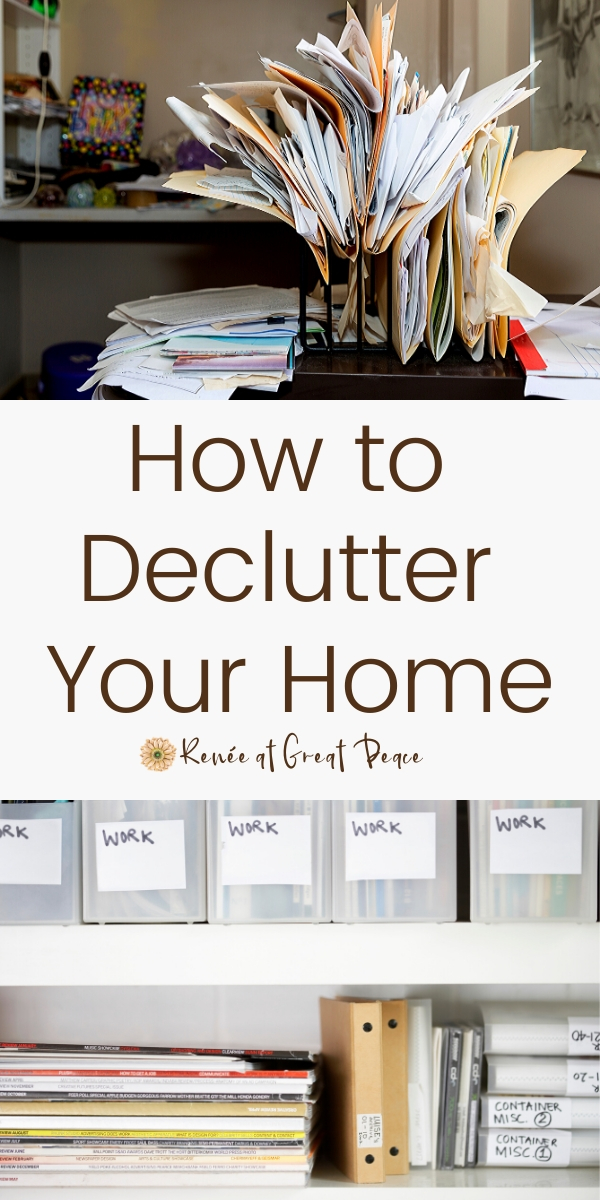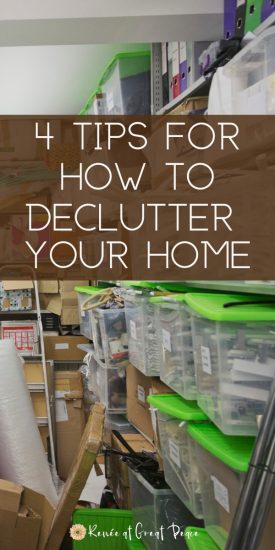
How to Declutter Your Home
We’re nearing spring! I don’t know about your home but in ours can get a bit cluttered in the winter months. So, as spring comes on it’s the perfect time to declutter your home.
There are a few secrets that I want to share with you to help you get your home organized and more importantly to keep it decluttered throughout the spring, summer and hopefully through fall months as well.
This post contains affiliate advertisement links.
Declutter Your Home by Assigning a Place for Everything
One secret to decluttering your home is to assign a place for everything. Every item in your home should have a logical place where it belongs. It should have it’s own home, so to speak.
This certainly isn’t a new idea. Maybe you’ve heard the old adage, “A place for everything and everything in it’s place.“
But, overtime when you live day to day in your house those things get moved from one place to another and eventually things can get lost in a pile of clutter.
The reason this step is important for you when you are decluttering your home is because if you know where each item’s home is, you’ll be easier able to find something you need at any given moment. Plus, it’ll be to your advantage to keeping a decluttered home if you know where to put things while you are cleaning.
Just the other day I asked my husband where he had placed the checkbook because in my mind he had it last. He said, I handed it to our son and asked him to give it to you. That checkbook was not in my wallet. It was not in it’s home. So, I had to begin a search for it. I looked everywhere I could think of and it wasn’t in any obvious location.
Finally, one by one, I started going through a stack of papers. Those papers had not been sorted properly and were not in their assigned homes. And, that’s where I found the checkbook buried in that pile of papers. So, I sorted each item moved everything to it’s proper ‘home’ and our coffee stand, suddenly looks less cluttered.
How Assigning Everything a Place Helps you to Declutter Your Home
Here are four tips for implementing this step as you start the process of to declutter your home.
A Logical Place for Everything
I find great satisfaction in nesting a home that’s warm and inviting! Part of that is ensuring that my home is visually decluttered. But, I’ve been known to stash things out of sight. The problem with that is, out of sight, out of mind. Which means that even if my home looks cluttered free, behind doors and in drawers there can be quite a lot of clutter.
So, the best solution is to organize all those hidden places and put things in a logical place. In our society we tend to have a lot of stuff and the longer we are in a home the more stuff we accumulate. But, if we don’t know where to find those items they essentially are useless.
If everything in our home resides within it’s own logical place, somewhere in which the item will be easily accessible and readily available means you can find it and utilize it whenever you need it.
This means thinking clearly about the items usage, and where and when you are most likely to need it. Then assigning a place that logically makes sense so that when you need the item it’s there, at hand, and ready for usage. But also, having it in a logical place means that you can easily return it to that location when you’ve finished with it. This way, you won’t waste time looking for it the next time you need it.

Start with a Clean Slate
Anytime is a good time to get started with organization. I suggest starting with one room at a time and dedicating a good amount of time to each space. Trying to do the whole house in one day will just wear you out. Spreading it out, a couple times a week, over the next few weeks will give you the time you need without overwhelming you.
Begin in each room by pulling all the clutter together, if in the bedroom lay it all on the bed, in the dining room or kitchen lay it all on a table.
Once the clutter is out of the way, clean all the surfaces, vacuum, you can even clean the windows. Why would you want to put clutter into spots that aren’t clean? Nope! Now is the time to clean and freshen. Once done, sort all the items into logical places in the room. If you come across items that don’t belong in the room, immediately remove them placing them in the room you want them to be in.
As you work, consider each item and ask yourself these questions.
- Is it a necessity in your home?
- What purpose does it serve?
- Where do you use the item?
- How can you make it most easily accessible?
- What logical place can be it’s home?
If the item is not a necessity, or doesn’t serve a purpose, or simply you have nowhere to put it. Consider getting rid of it. If it’s trash, immediately throw it away. If it’s still a useful item but you have no need for it, keep a pile of things to donate, and a pile of things to sell (but only if you are actually going to try to sell the item).
Read some great tips for what to do with items you intend to purge while decluttering your home.
Remember the best time to organize is after you’ve cleaned, and purged. It makes no sense to try organizing if you have too many things that need to be thrown out or given away.
Assign Each Item to a Room
As you work each item that you keep should be assigned to a room of your house. Think about this logically. In what room does the item most often get used?
Shop Organization Supplies
It makes no sense to keep piano books on a shelf in a child’s bedroom if their piano is in the family room. Those could go on a shelf beside the piano.
Items like paper, pens, and scissors are more likely used in an office, family room, or homeschool room. Or, they could be better suited to your child’s bedroom if they have a work space for crafts.
Kitchen items should logically be placed in the kitchen. Think logically about each closet in the home. What is it’s best possible purpose? What can you store in those that makes life easier?
Keeping everything in the room where it’s most used is a logical solution to clutter. Blankets, sheets, pillows naturally belong in bedrooms.
As you work in each room, remove items that do not belong in that room, returning them or assigning them to a room of their own.
Assign Each Item it’s Own Home Within it’s Room
Once you’ve removed items that don’t belong in the room. It’s time to organize what’s left. Think logically here. In your bedroom place clothing in the closet, or dresser drawers. Maybe you have a shelf or two where you can put a jewelry box for jewelry. Also, I find keeping a small sewing kit in my bedroom closet is a handy for sewing on a button or stitching up a small tear when the time arises.
Keep similar items together. A hanging shoe rack is a good place to keep all your shoes together and tidy. Underwear can go in one drawer while socks in another. Perhaps, hang scarves from an over the door hanger. Which can free up shelf space.
Try to keep similar items together in the same place. This frees up time when you are in a hurry because you’ll know exactly where to find the item.
Examples of Assigning a Logical Place for Everything
- Rather than storing extra toilet paper in a hall closet why not assign a place under the bathroom sink or in a nice basket? This is where it’s used and is easily accessible when needed.
- The same could be done with towels, rather than in a closet in the hallway, figure out a way for them to be stored in the bathroom. Perhaps you could add a shelf on the wall, or roll and place in a nice basket.
- Books, though a lovely and wonderful group of items around the home, can become a cluttered mess when strewn here and there and yonder. So, devising a system for each person to have the books they need, yet stored in an accessible and decorative way keeps book clutter at bay. Logical places for books can be small shelves in each room, bedside tables, and even in decorative baskets thoughtfully placed next to where they get read; beds, sofas, bathrooms, etc.
- For books you no longer need, consider donating them. Little free libraries are popping up around the country. These small boxes are thoughtfully placed near parks and schools and make it easy to leave or take a book as you wish.
- Create an incoming mail system near where everyone tends to drop the mail. For us, mail gets dropped on a table in the kitchen. So, I created a mail organizing system. A place for new mail. Once sorted, there is a folder for bills to be paid, and one for other things that need attention, the rest, the junk mail, gets trashed. Everything is where I need it, when I need it. Your go to spot might be in the office, family room, or bedroom depending on where you manage your mail, and pay your bills.
As you work through your home and incorporate these steps, remember to choose storage locations that are logical and makes sense to you. Just because your bestie stores her make up in the bathroom drawer doesn’t mean you can’t store it in a dresser drawer in the bedroom if you are more likely to get dressed there.
It can be a challenge to declutter and organize your home, especially, if this isn’t something you are used to doing. With these tips, practice, time, and a commitment to keeping an organized home you’ll soon have your home feeling like a sanctuary rather than a second-hand store.
- 5 Household Chores You Should do Every Day
- 8 Homemaking Tips to Organize Your Pantry
- 5 Homemaking Tips for Homeschool Moms
Towel Photo by Denny Müller on Unsplash









